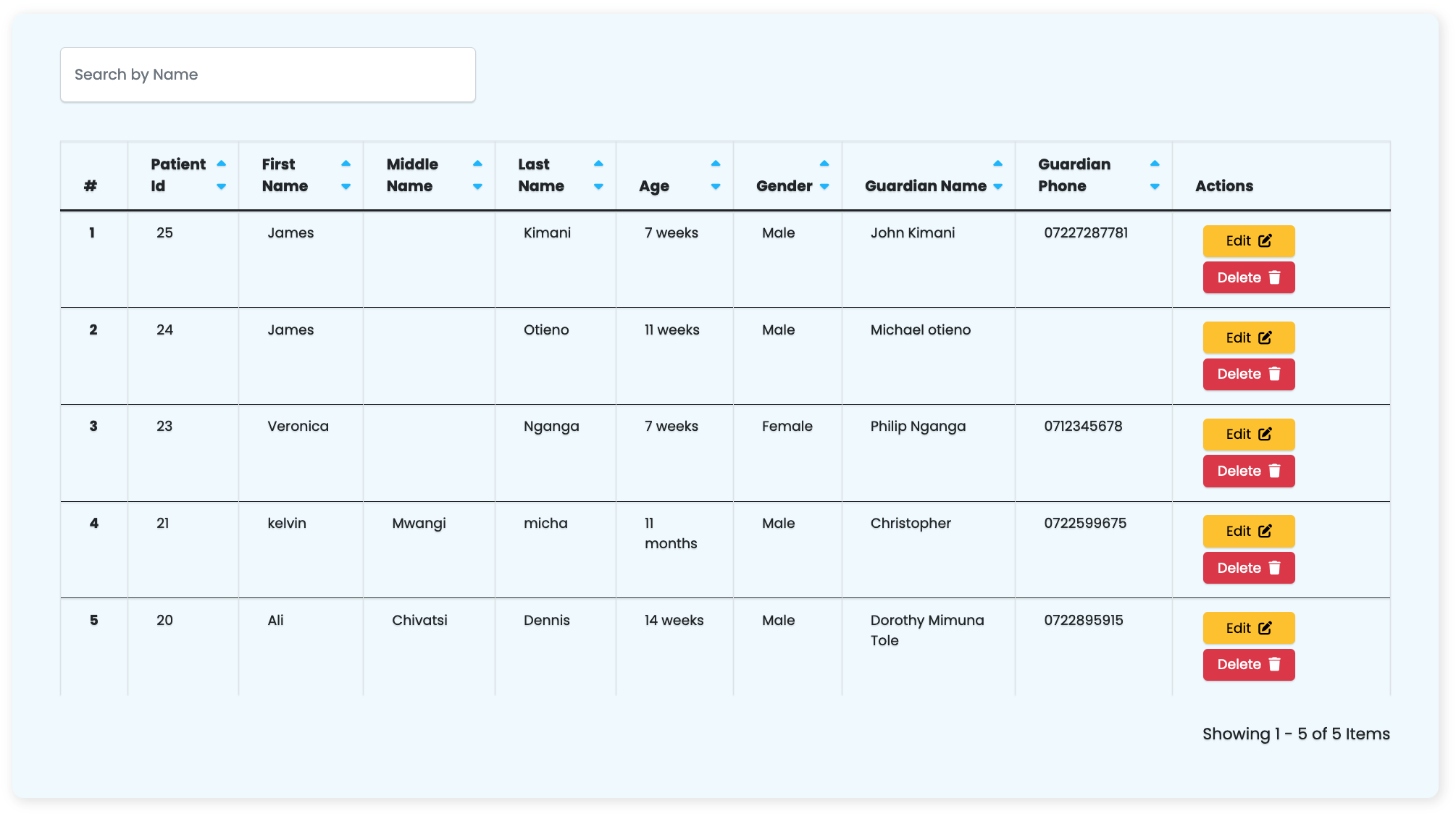Usage
- In this tutorial, we will use a hospital records management system to demonstrate the library's usage. The example below shows an example to render a patient records table.
Backend Integration
- Import the
TablesModulefrom@sisitech/tablesin yourapp.module.ts.
import { TablesModule } from '@sisitech/tables';
@NgModule({
imports: [
// ...
TablesModule.forChild(authConfig),
],
})
- Configure
authConfigwith the appropriate authentication settings for your backend API.
Frontend Integration
In your component's HTML file (e.g., immunize.component.html), use the <my-app-tables> element to display your data table. Customize it according to your needs. Here's a sample usage:
<div class="">
<my-app-tables
[alerts]="alerts"
deletePreText="Do you wish to delete"
deleteFieldDisplayField="@name"
[enableView]="true"
[enableDelete]="true"
[enableAdd]="enableDelete"
[formFilters]="formFilters"
[args]="args"
[listTypeUrl]="url"
(actionsEvent)="handleActions($event)"
[headers]="myHeaders"
searchFieldName="name"
searchFieldNameMessage="Name"
[enableOrderBy]="enableOrderBy"
(onStatusChange)="onDeleteStatus($event)">
</my-app-tables>
</div>
MyTables Inputs
Here is a breakdown of the different inputs passed to MyTables:
| Inputs | Is Required | Description |
|---|---|---|
listTypeUrl |
✅ | URL to fetch data for the table. |
headers |
✅ | Configuration for table headers. |
alerts |
x | An array of alerts for user notifications. |
deletePreText |
✖️ | Text displayed before a delete confirmation message. |
deleteFieldDisplayField |
✖️ | Field used to display data for delete confirmation. |
enableView |
✖️ | Enable viewing details of table entries. |
enableDelete |
✖️ | Enable deleting entries from the table. |
enableAdd |
✖️ | Enable adding new entries to the table. |
formFilters |
✖️ | Filters for the table. |
args |
✖️ | Additional arguments for the table. |
searchFieldName |
✖️ | Field used for searching. |
searchFieldNameMessage |
✖️ | Message displayed for the search field. |
enableOrderBy |
✖️ | Enable sorting by columns in the table. |
MyTables Configuration
- This section includes the initialization of variables, such as
dataMapandalerts. ThengOnInitmethod is called when the component is initialized. - The class members below define configuration settings for
MyTables, such asargs,enableDelete,enableOrderBy,url, andinstance.
Handling Filters
- The onFilters method is called when filters are applied, and it updates the formFilters variable.
MyHeaders Configuration
- The
myHeadersarray contains configuration for table headers. You can define how each column should be displayed here. - The
myHeadersarray in your component specifies the configuration for table headers. Each item in the array defines how a column should be displayed. For example: "source"represents the field name in your data source."name"is the display name for the column."source_func"allows you to apply custom formatting to the data."source_interpolated"lets you combine multiple fields for display.
myHeaders = [
{
"source": "id",
"name": "Patient ID"
},
{
"source_interpolated": "@first_name @middle_name# @last_name#",
"name": "Full Name"
},
{
"name": "Created FUnc",
"source_func": (val: any) => {
var date = "@created#".interpolate(val).split("T")[0]
return date.toDateDisplay()
}
},
{
"source": "dob",
"name": "Date Of Birth"
},
{
"source": "gender",
"name": "Gender"
},
{
"source": "guardian_name",
"name": "Guardian Name"
},
{
"source": "guardian_phone",
"name": "Guardian Phone"
},
]
Handling Deletion Status
- The
onDeleteStatusmethod handles deletion status. It updates thealertsarray with a notification when a vaccine is deleted.
onDeleteStatus(instance: any) {
if (typeof instance != "boolean") {
this.alerts = [
{
options: { level: "danger" },
message: "Vaccine @name# deleted.",
instance: instance,
}
]
}
}
Handling Actions
- The
handleActionsmethod is called when actions are triggered in the table, such as editing or viewing details. - It navigates to the appropriate routes and interacts with the view modal.
async handleActions(event: any) {
this.instance = null
if (event.name == "Edit") {
const data = event.data;
console.log(data, 'customers')
await this.route.navigate(['../customers/add'], { state: data });
} else if (event.name == "Add") {
const data = event.data;
this.instance = data
console.log(data, 'add');
if (!this.viewModalRef) {
console.log("✖️ button found")
return
}
const viewModalButton = this.viewModalRef.nativeElement as HTMLButtonElement
viewModalButton.click()
} else if (event.name == "View") {
const data = event.data;
this.instance = data
console.log(data, 'View');
if (!this.viewModalRef2) {
console.log("✖️ button found")
return
}
const viewModalButton2 = this.viewModalRef2.nativeElement as HTMLButtonElement
viewModalButton2.click()
}
}
Rendered Table
- The image below shows the expected final output of the rendered table:
